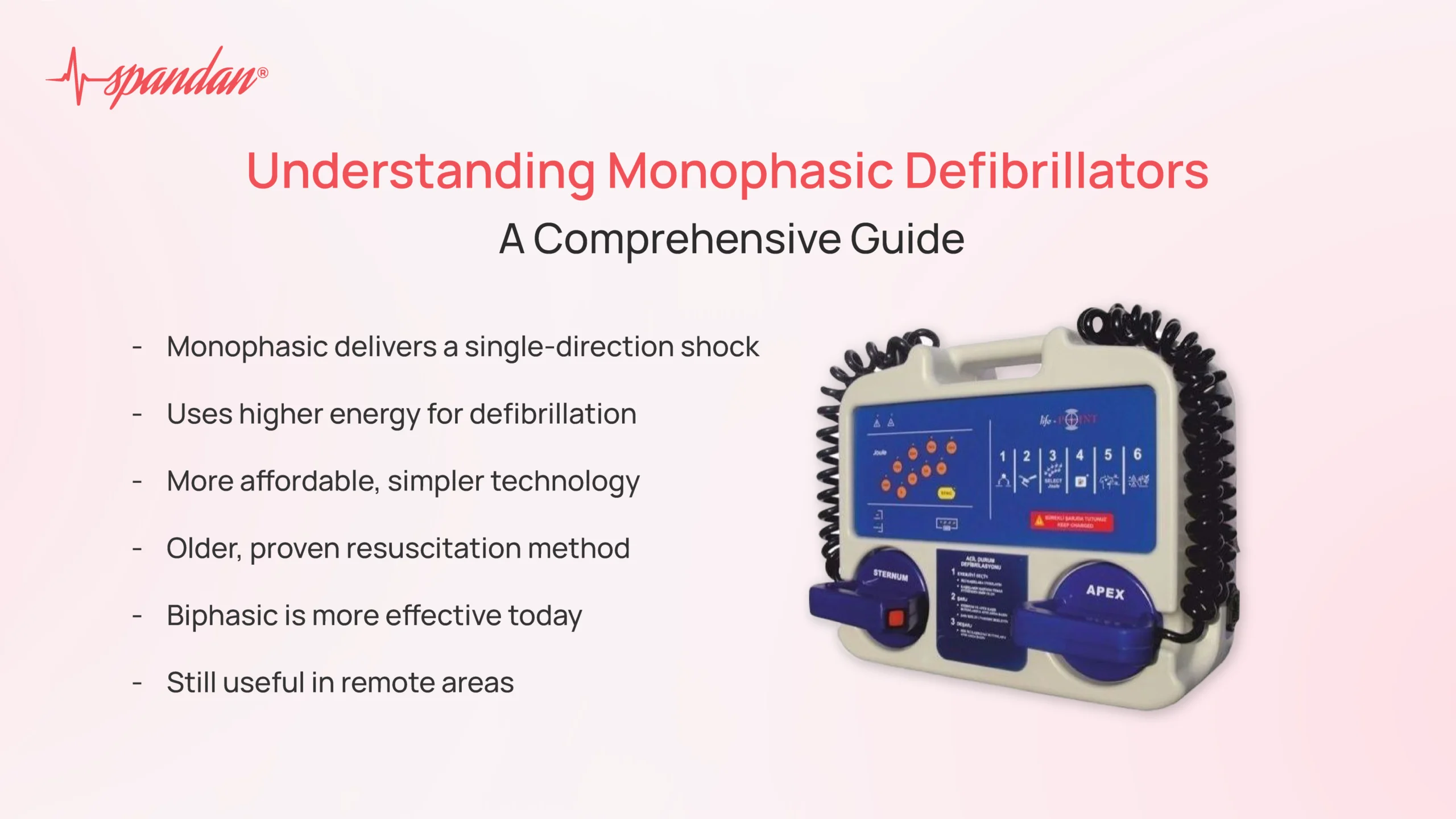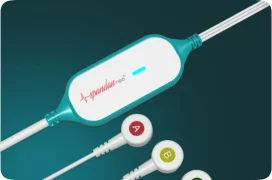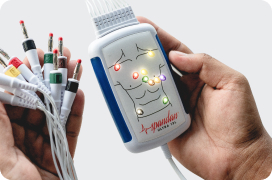
Related Article
Author:- Mr. Ritesh Sharma
When it comes to saving lives during sudden cardiac arrests, the defibrillator is an indispensable tool. Among the various types of defibrillators, the monophasic defibrillators has been one of the foundational technologies in resuscitation efforts. While newer models like biphasic defibrillators have become more prevalent, the monophasic defibrillator still holds significant relevance in certain medical settings. This blog will delve into what a monophasic defibrillator is, how it works, its advantages and limitations, and why understanding this device is still crucial for medical professionals.
What is a Monophasic Defibrillator?
A monophasic defibrillator is a medical device used to deliver an electric shock to the heart in order to treat life-threatening arrhythmias, including ventricular fibrillation and pulseless ventricular tachycardia. The term “monophasic” refers to the waveform of the electrical current delivered by the defibrillator. In a monophasic defibrillator, the current travels in a single direction from one electrode to another, passing through the heart in a single phase. This is in contrast to biphasic defibrillators, where the current reverses direction halfway through the shock.
How Does a Monophasic Defibrillator Work?
To understand the workings of a monophasic defibrillator, it’s essential to first understand the basic principles of defibrillation. The heart operates on electrical signals that prompt it to contract and pump blood throughout the body. When these signals are disrupted, it can result in arrhythmias that prevent the heart from pumping effectively. Defibrillation works by delivering a controlled electric shock to the heart, which momentarily stops all electrical activity, giving the heart an opportunity to reset to its normal rhythm.
In a monophasic defibrillator, the shock is delivered using a high-energy single-phase waveform. The electrical current flows in one direction from one paddle (or pad) placed on the patient’s chest to the other. This type of defibrillation requires a higher energy level, often between 200 to 360 joules, to be effective. The goal is to depolarize the heart cells simultaneously, allowing the natural pacemaker of the heart to re-establish a normal rhythm.
Key Advantages of Monophasic Defibrillators
Despite the advancement in technology, the monophasic defibrillator still offers some key advantages that make it useful in specific situations:
- Simplicity: The technology behind monophasic defibrillators is straightforward, making these devices easy to use. Their operation is less complex than newer models, which can be advantageous in emergency situations where time is of the essence.
- Cost-Effectiveness: These defibrillators are generally more affordable than their biphasic counterparts. This cost difference can be significant in settings with limited budgets, such as rural hospitals or clinics in developing regions.
- Proven Efficacy: While biphasic defibrillators are now more commonly used, monophasic defibrillators have a long history of successful use in resuscitation efforts. Many older studies supporting the efficacy of defibrillation were conducted using monophasic defibrillators.
Limitations of Monophasic Defibrillator
Despite their advantages, monophasic defibrillators do have limitations that have led to the rise of biphasic technology:
- Higher Energy Requirements: Monophasic defibrillators require higher energy levels to achieve effective defibrillation. This can increase the risk of damage to the heart muscle and other tissues surrounding the heart.
- Lower Success Rates: Research has shown that biphasic defibrillators, which use a lower energy level, have higher first-shock success rates in terminating arrhythmias compared to this defibrillators. This can be critical in life-saving situations.
- Increased Risk of Side Effects: The higher energy levels used by monophasic defibrillators can lead to a greater incidence of post-shock complications, such as skin burns and myocardial damage.
Applications of Monophasic Defibrillator Today
While the medical field has largely moved toward biphasic defibrillators due to their increased efficacy and safety, monophasic defibrillator is still used in certain situations:
- Military and Remote Locations: In locations where resources are limited and cost is a significant concern, monophasic defibrillators may be preferred due to their lower cost and ruggedness.
- Training and Education: Many medical training programs still use monophasic defibrillators to teach the basic principles of defibrillation. Understanding how these devices work is essential for understanding the evolution of defibrillation technology.
- Backup Devices: Some medical facilities maintain defibrillators as backup devices. In the event that a biphasic defibrillator is unavailable or malfunctioning, a monophasic device can still be used effectively.
The Future of Monophasic Defibrillators
The medical community’s shift toward biphasic defibrillators doesn’t necessarily spell the end for the monophasic defibrillator. As technology advances, it’s possible that improvements could be made to the monophasic waveform that would enhance its efficacy while reducing energy requirements. Additionally, in situations where cost and simplicity are paramount, the monophasic defibrillator may continue to be a valuable tool in the medical arsenal.
Moreover, understanding monophasic defibrillators is crucial for medical professionals who may encounter older devices in various settings. The knowledge of how to operate a this defibrillator can make a difference in critical moments when newer technology may not be available.
The monophasic defibrillator represents an important chapter in the history of medical technology. While it has largely been surpassed by biphasic devices in many settings, it remains a relevant tool in specific applications, especially where cost, simplicity, and durability are significant considerations. For medical professionals, understanding the function, advantages, and limitations of defibrillators is essential for comprehensive knowledge of defibrillation techniques. As the field of emergency medicine continues to evolve, the defibrillator remains a testament to the progress made in the fight against sudden cardiac arrest.




